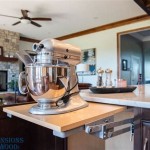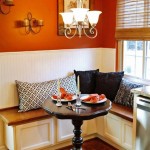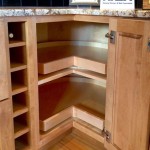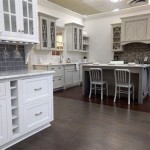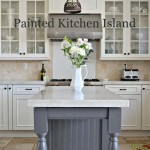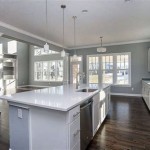Recessed LED Lights For Kitchen: A Comprehensive Guide
The kitchen, often considered the heart of the home, requires careful consideration when it comes to lighting. Effective illumination not only enhances the aesthetic appeal of the space but also contributes significantly to functionality and safety. Recessed LED lights have emerged as a popular and versatile lighting solution for kitchens, offering a blend of style, efficiency, and performance.
This article explores the various aspects of recessed LED lighting for kitchens, covering their benefits, types, installation considerations, and factors to consider when selecting the appropriate fixtures. Understanding these elements is crucial for creating a well-lit and visually appealing kitchen environment.
Understanding the Benefits of Recessed LED Kitchen Lighting
Recessed LED lights offer a multitude of advantages over traditional lighting options, making them a preferred choice for modern kitchens. These benefits extend to energy efficiency, aesthetics, and functionality.
One of the primary advantages of LED lighting is its energy efficiency. LEDs consume significantly less electricity compared to incandescent or halogen bulbs, translating to lower energy bills and a reduced carbon footprint. This difference stems from the way LEDs produce light. Incandescent bulbs generate light by heating a filament, which is an inefficient process that releases a significant amount of energy as heat. LEDs, on the other hand, use semiconductors to convert electricity directly into light, minimizing energy waste.
In addition to energy efficiency, LEDs boast a considerably longer lifespan than traditional bulbs. A typical LED bulb can last for tens of thousands of hours, significantly reducing the frequency of replacements. This extended lifespan not only saves money on replacement costs but also minimizes the inconvenience associated with changing bulbs, especially in hard-to-reach areas. The long lifespan also contributes to environmental sustainability by reducing waste and the need for frequent manufacturing.
From an aesthetic perspective, recessed lights offer a clean and unobtrusive appearance. They are installed flush with the ceiling, creating a seamless and integrated look that complements various kitchen styles. This minimalist design avoids visual clutter and helps to create a more spacious and airy feel. The versatility of recessed lighting allows for strategic placement to highlight specific areas or features within the kitchen.
Functionally, recessed lighting provides even and consistent illumination, reducing shadows and glare. This is particularly important in the kitchen, where tasks such as food preparation require adequate lighting for safety and accuracy. The ability to control the brightness and color temperature of LED lights further enhances their functionality, allowing for customization to suit different tasks and preferences.
Furthermore, LEDs generate very little heat compared to traditional lighting options. This is a significant advantage in the kitchen, where minimizing heat buildup can contribute to a more comfortable working environment, especially during warmer months. The reduced heat also reduces the risk of damage to surrounding materials and helps to prolong the lifespan of the fixtures themselves.
Types of Recessed LED Lights for Kitchens
Recessed LED lights are available in a variety of types, each with its own characteristics and suitability for different applications. Understanding these variations is essential for selecting the appropriate fixtures for a specific kitchen layout and design.
One common type is the standard recessed can light, which consists of a housing that is installed within the ceiling and a trim that is visible from below. These fixtures are typically used for general ambient lighting and are available in a range of sizes and trim styles. The trim style can significantly impact the look of the light, ranging from simple and functional to decorative and ornate.
Another option is the gimbal recessed light, which features an adjustable bulb holder that allows the light to be directed at a specific angle. This type of fixture is ideal for accent lighting, highlighting artwork, or illuminating specific areas of the kitchen, such as countertops or work surfaces. The adjustability of gimbal lights provides flexibility in directing light where it is needed most.
Slim panel LED lights, also known as wafer lights, are a relatively new type of recessed lighting that is becoming increasingly popular. These fixtures are extremely thin and have a low profile, making them ideal for installations where ceiling space is limited. They are easy to install and provide a uniform and diffused light output. Slim panel lights are a good choice for kitchens with low ceilings or where traditional recessed cans would be difficult to install.
Wet-rated recessed lights are specifically designed for use in damp or wet environments, such as bathrooms and kitchens. These fixtures are sealed to prevent moisture from entering the housing and causing electrical hazards. Wet-rated lights are essential for installation above sinks or near dishwashers to ensure safety and prevent damage.
Color-changing LED recessed lights offer the ability to adjust the color temperature and even the color of the light. These fixtures can be used to create different moods and atmospheres in the kitchen, allowing for customization based on personal preferences and the occasion. Color-changing lights are often controlled via a remote control or smartphone app.
The choice of recessed light type should be based on the specific lighting needs of the kitchen, the available ceiling space, and the desired aesthetic. Consider the function of each area within the kitchen and select fixtures that provide adequate and appropriate illumination.
Installation Considerations for Recessed LED Kitchen Lighting
Proper installation is crucial for ensuring the safety and performance of recessed LED lighting. While some homeowners may be comfortable with DIY installation, it is generally recommended to hire a qualified electrician to handle the wiring and installation process.
Before starting the installation, it is important to plan the layout of the lights. Consider the size and shape of the kitchen, the location of cabinets and appliances, and the desired lighting effect. A well-planned layout will ensure even illumination and minimize shadows. It is helpful to create a lighting plan that shows the location of each fixture and the spacing between them.
When installing recessed lights in an existing ceiling, it is necessary to locate and avoid electrical wiring, plumbing, and HVAC ductwork. Use a stud finder to locate ceiling joists and avoid cutting into structural elements. If there are obstructions in the ceiling cavity, it may be necessary to adjust the layout or use slim panel lights that require less space.
Wiring recessed lights requires connecting the fixtures to the electrical circuit. Ensure that the circuit is properly grounded and that the wiring is properly sized to handle the load. Always turn off the power to the circuit before working with electrical wiring. If you are not comfortable working with electricity, it is best to hire a qualified electrician.
The installation of recessed cans typically involves cutting holes in the ceiling to accommodate the housings. Use a hole saw that is the correct size for the fixture and take care not to damage the surrounding ceiling material. After the holes are cut, the housings can be inserted and secured to the ceiling joists.
When installing insulation around recessed lights, it is important to use IC-rated (Insulation Contact) fixtures. These fixtures are designed to be in direct contact with insulation without overheating. Non-IC-rated fixtures can overheat and pose a fire hazard if they are covered with insulation. Ensure that the insulation does not block the airflow around the fixture.
After the housings are installed and wired, the trims can be attached. The trim is the visible part of the fixture and is typically held in place by clips or springs. Ensure that the trim is securely attached and flush with the ceiling surface.
For slim panel lights, the installation process is typically simpler. These fixtures often come with spring clips that allow them to be easily installed into the ceiling without the need for a separate housing. The wiring is typically connected using quick-connect connectors.
Factors to Consider When Selecting Recessed LED Lights
Choosing the right recessed LED lights for a kitchen involves considering several factors, including brightness, color temperature, beam angle, and energy efficiency. Evaluating these factors will ensure that the selected fixtures meet the specific needs of the space and provide the desired lighting effect.
Brightness is measured in lumens, which indicates the amount of light emitted by the fixture. The appropriate lumen output for a kitchen depends on the size of the space and the desired level of illumination. As a general guideline, aim for approximately 500-800 lumens per square foot for task lighting and 300-500 lumens per square foot for ambient lighting. Consider the height of the ceiling as well; higher ceilings will require brighter lights to adequately illuminate the space.
Color temperature is measured in Kelvin (K) and indicates the warmth or coolness of the light. Lower Kelvin values (e.g., 2700K-3000K) produce a warm, yellowish light, while higher Kelvin values (e.g., 4000K-5000K) produce a cool, bluish light. For kitchens, a color temperature of 3000K-4000K is generally recommended, as it provides a balanced and natural-looking light that is suitable for both task lighting and ambient lighting. Warmer light can create a cozy atmosphere, while cooler light can provide a more energetic and focused environment.
The beam angle of a recessed light determines the spread of the light. A narrow beam angle is ideal for accent lighting, while a wide beam angle is better for general illumination. Consider the size and shape of the kitchen when selecting the appropriate beam angle. For smaller kitchens, a wider beam angle may be sufficient, while larger kitchens may require a combination of wide and narrow beam angles to achieve even illumination.
Energy efficiency is another important factor to consider. Look for LED lights with a high efficacy rating, which indicates the amount of light produced per watt of electricity consumed. Energy-efficient lights will save money on energy bills and reduce the environmental impact. Consider checking the Energy Star rating to ensure that the lights meet certain energy efficiency standards.
The design and finish of the recessed light trim should complement the overall aesthetic of the kitchen. Choose a trim style that matches the kitchen cabinets, appliances, and other fixtures. Common trim finishes include white, brushed nickel, and black. Consider the shape of the trim as well; round trims are a classic choice, while square trims offer a more modern look.
Finally, consider the dimming capabilities of the recessed LED lights. Dimmable lights allow for adjusting the brightness to suit different tasks and create different moods. Ensure that the dimmer switch is compatible with the LED lights to avoid flickering or other issues. Dimming capabilities provide flexibility and control over the lighting in the kitchen.

Commercial Electric Slim Baffle 3 In Color Selectable Canless Led Recessed Kit 91292 The Home

Recessed Lighting Buying Guide The Home

How To Plan Kitchen Recessed Lighting

How To Update Old Kitchen Lights Recessedlighting Com

Modern Recessed Lighting For Every Home And Office Space Delmarfans Com

The Difference Between Can Lights Vs Recessed And How To Make A Choice For Your Home Angi

Choosing The Best Led Recessed Lighting What You Should Know Prolighting

Kitchen Recessed Lighting A Complete Guide Bees

Kitchen Recessed Lighting Layout And Planning Ideas Advice Lamps Plus

Commercial Electric Pro Value Series Led 4 In Round Adj Color Temp Canless Recessed Light For Kitchen Bath Living Rooms Wht 12 Pk 92085 The Home

